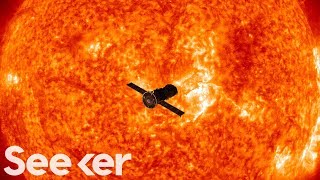(单词翻译:单击)
Living down here on Earth it's easy to forget that we have it pretty good, at least in terms of our environment not doing everything it can to destroy us and everything we love.
生活在地球上,我们很容易忘记,我们过得不错,至少在这样的环境中,我们和我们所爱的一切能够生存下来。
But that's not the case in space, and scientists have had to solve all sorts of challenges to keep space stations, probes, and satellites functioning in such an extreme environment.
但在太空中,可就不行了,为了让空间站、探测器和卫星在极端环境中正常工作,科学家们必须应对各种挑战。
For example, they have to engineer their way around problems like temperature.
比如像温度,就是他们必须要解决的问题。

Space can be extremely cold; the background temperature of space is minus two hundred seventy degrees celsius in the shade, just a few degrees above absolute zero.
太空环境可能会非常寒冷;在背阴处,宇宙空间温度低至零下二百七十摄氏度,仅比绝对零度高出几度。
But in direct sunlight radiation can warm a spacecraft hundreds of degrees, especially when it's closer to the sun.
但在阳光直射下,太阳辐射会加热航天器,使之升温几百度,尤其是离太阳近时,更是如此。
Temperature extremes like this cause the equipment to contract and expand which can damage or shatter it, and depending on the mission, engineers will have to either insulate their spacecraft from the cold or protect it from the heat.
极端温度会导致仪器热胀冷缩,损坏仪器,而根据任务,工程师们需要保障航天器免受寒冷或高温困扰。
Sometimes they'll have to do both!
有时还要同时做到!
The European Space Agency's Rosetta mission had to chase down a comet.
欧洲航天局的罗塞塔任务是要捕获彗星。
To get there Rosetta had to do several planetary flybys before heading out towards the asteroid belt.
要抵达彗星所在位置,罗塞塔需要做几次行星(定点)飞跃,然后向小行星带进发。
On its ten year journey it went through wild temperature fluctuations, so to overcome this engineers fitted Rosetta with metal slats or "louvres" that could open to let heat radiate away or close to trap it and keep the probe warm.
在其十年的行程中,它经历了剧烈的温度变化。为了适应这种温度变化环境,工程师们为罗塞塔安装了金属板或叫做"百叶窗",这样(热时)罗塞塔可以打开"百叶窗"散热,接近捕获时,关闭"百叶窗",为探头保暖。
Comets like the one rosetta caught leave a trail of dust in their wake, and are frequently the cause of meteor showers we see on Earth.
像罗塞塔这样捕获的彗星,彗尾上都有一道尘埃,通常这就是我们在地球上看到的流星雨。
Those little dust particles can also pose a threat to spacecraft because they're traveling at thousands of kilometers per hour.
这些微小的尘埃颗粒以每小时数千公里的速度行驶,因此也会对航天器构成威胁。
These can have the effect of sandblasting solar arrays, harming optics, or damaging the structure outright.
这就像对着太阳能电池板喷砂,会直接给帆板造成光学及结构损伤。
The best strategy is avoidance -- chart a course where you don't think there's going to be a lot of debris, but if it's unavoidable there's still measures you can take.
最好的办法是避开它们——规划一个你认为碎片较少的路线,但如果不行,还有(其他)办法。
When the Hubble telescope passes through a meteor shower, scientists will rotate it so those big solar panels are edge-on to the incoming hazard, minimizing its surface area like a fencer standing sideways.
哈勃望远镜穿越流星雨时,科学家们会将其旋转,让太阳能电池板的边缘应对流星风险,减少其撞击面积,就像击剑运动员侧身站立一样 。
But even if a spacecraft can keep itself at the right temperature and avoid physical impacts, there's another hazard that will always get them in the end.
但即便航天器能够保持适当温度,避免物理撞击,还有一种危险,终是难以躲过。
Spacecraft are exposed to extreme radiation, mostly in the form of high-energy charged particles.
宇宙飞船会暴露在极强的(宇宙)辐射下,这些辐射主要以高能带电粒子的形式存在。
These particles can come from the sun or just be zipping around the galaxy as cosmic rays.
这些粒子或来自太阳或就来自于穿梭于(整个)银河系的宇宙射线。
They can also be trapped by the Earth's magnetic field and form enormous bands of protons and electrons called Van Allen belts.
地球磁场也可能将航天器困住,从而形成巨大的质子和电子带,称为范艾伦带。
Not only do these particles pose a threat to humans, but they can damage the electronics of spacecraft as well.
这些粒子不仅对人类构成威胁,也会损坏航天器中的电子设备。
They can cause a current to flow on the surface of the craft, or burn out chips.
它们可能导致飞行器表面的电流流动,或可能烧毁芯片。
They can even change the contents of memory cells, corrupting data the spacecraft's computers need to function.
它们甚至可以改变存储单元中的内容,破坏航天器中计算机所需的数据。
If the computers fail or valuable data gets corrupted, the whole mission can be a bust, so engineers have to come up with strategies to protect electronics from radiation in space, what's known as "space hardening".
如果计算机失灵或有价值的数据遭到破坏,整个任务都可能会崩溃,因此工程师们必须想出保护电子设备免受空间辐射的办法,即所谓“空间硬化”。
They can try and shield the electronics, but shielding is heavy and weight adds cost to the launch.
他们可以尝试屏蔽电子设备,但屏蔽(材料)很重,这些重量会增加发射成本。
Spacecraft can have redundant electronics, like three chips performing the same operation simultaneously.
航天器可以备份电器元件,比如三个芯片同时执行相同的操作(任务)。
If radiation causes one to make an error, the other two can check its work and overrule it.
如果辐射导致一个出现错误,其他两个可以检查其工作内容并予以修正。
This way they can just use commercial electronics, which are cheaper.
这样他们就可以使用经济的商用电器元件了。
Interestingly, electronics today are more sensitive to space radiation than they were in the 60s and 70s.
有趣的是,相比60年代70年代的电器元件,今天的电器元件对空间辐射更为敏感。
To make them more robust the chips themselves can be designed in such a way that makes them resistant to radiation.
为使它们更加耐用,我们可以设计防辐射芯片。
Designing hardened chips is difficult and expensive though, and one of the most popular chips still in use has the processing power of a laptop from almost two decades ago.
但是,设计硬化(防辐射)芯片困难而又昂贵。有一种具有笔记本电脑处理能力的芯片,现在仍在使用而且流行甚广,历史已有20年了。
Even with all these precautions, even the best space-born electronics will still fail eventually.
即便采用种种预防措施,即使是最好的太空电子产品最终也将难逃厄运。
For more epic stories of innovation that shaped our future, check out TheAgeOfAerospace.com.
要想了解更多改变未来的创新故事,请点击TheAgeOfAerospace.com.查看。
If you like this video don't forget to subscribe.
如果你喜欢这期节目,不妨订阅。
Despite the challenges we have launched an absurd number of satellites up there.
尽管面临种种挑战,我们仍向宇宙空间中发射了众多卫星。
Is there room for any more?
继续发射,还有地方么?
Amy covers that here.One cool thing about Rosetta's louvres is they opened and closed automatically.
艾米为您讲解。罗塞塔的百叶窗很酷,因为他们可以自动开合。
The springs were temperature sensitive because of the metals they were made of and so they used no power.
弹簧是温度敏感元件,因为制作弹簧的金属本身就是热敏元件,所以他们无需额外动力。
Thanks for watching and stay tuned to Seeker!
谢谢观看,欢迎您继续锁定栏目!


